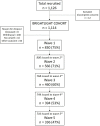Longitudinal cohort study of the impact of specialist cancer services for teenagers and young adults on quality of life: outcomes from the BRIGHTLIGHT study
- PMID: 33243793
- PMCID: PMC7692812
- DOI: 10.1136/bmjopen-2020-038471
Longitudinal cohort study of the impact of specialist cancer services for teenagers and young adults on quality of life: outcomes from the BRIGHTLIGHT study
Abstract
Objectives: In England, healthcare policy advocates specialised age-appropriate services for teenagers and young adults (TYA), those aged 13 to 24 years at diagnosis. Specialist Principal Treatment Centres (PTC) provide enhanced TYA age-specific care, although many still receive care in adult or children's cancer services. We present the first prospective structured analysis of quality of life (QOL) associated with the amount of care received in a TYA-PTC DESIGN: Longitudinal cohort study.
Setting: Hospitals delivering inpatient cancer care in England.
Participants: 1114 young people aged 13 to 24 years newly diagnosed with cancer.
Intervention: Exposure to the TYA-PTC defined as patients receiving NO-TYA-PTC care with those receiving ALL-TYA-PTC and SOME-TYA-PTC care.
Primary outcome: Quality of life measured at five time points: 6, 12, 18, 24 and 36 months after diagnosis.
Results: Group mean total QOL improved over time for all patients, but for those receiving NO-TYA-PTC was an average of 5.63 points higher (95% CI 2.77 to 8.49) than in young people receiving SOME-TYA-PTC care, and 4·17 points higher (95% CI 1.07 to 7.28) compared with ALL-TYA-PTC care. Differences were greatest 6 months after diagnosis, reduced over time and did not meet the 8-point level that is proposed to be clinically significant. Young people receiving NO-TYA-PTC care were more likely to have been offered a choice of place of care, be older, from more deprived areas, in work and have less severe disease. However, analyses adjusting for confounding factors did not explain the differences between TYA groups.
Conclusions: Receipt of some or all care in a TYA-PTC was associated with lower QOL shortly after cancer diagnosis. The NO-TYA-PTC group had higher QOL 3 years after diagnosis, however those receiving all or some care in a TYA-PTC experienced more rapid QOL improvements. Receipt of some care in a TYA-PTC requires further study.
Keywords: oncology; organisation of health services; quality in health care.
© Author(s) (or their employer(s)) 2020. Re-use permitted under CC BY-NC. No commercial re-use. See rights and permissions. Published by BMJ.
Conflict of interest statement
Competing interests: None declared.
Figures








References
-
- National Institute for Health and Care Excellence Guidance on cancer services: improving outcomes in children and young people with cancer. London: NICE, 2005. https://www.nice.org.uk/guidance/csg7/resources/improving-outcomes-in-ch...
Publication types
MeSH terms
Grants and funding
LinkOut - more resources
Full Text Sources
Medical
